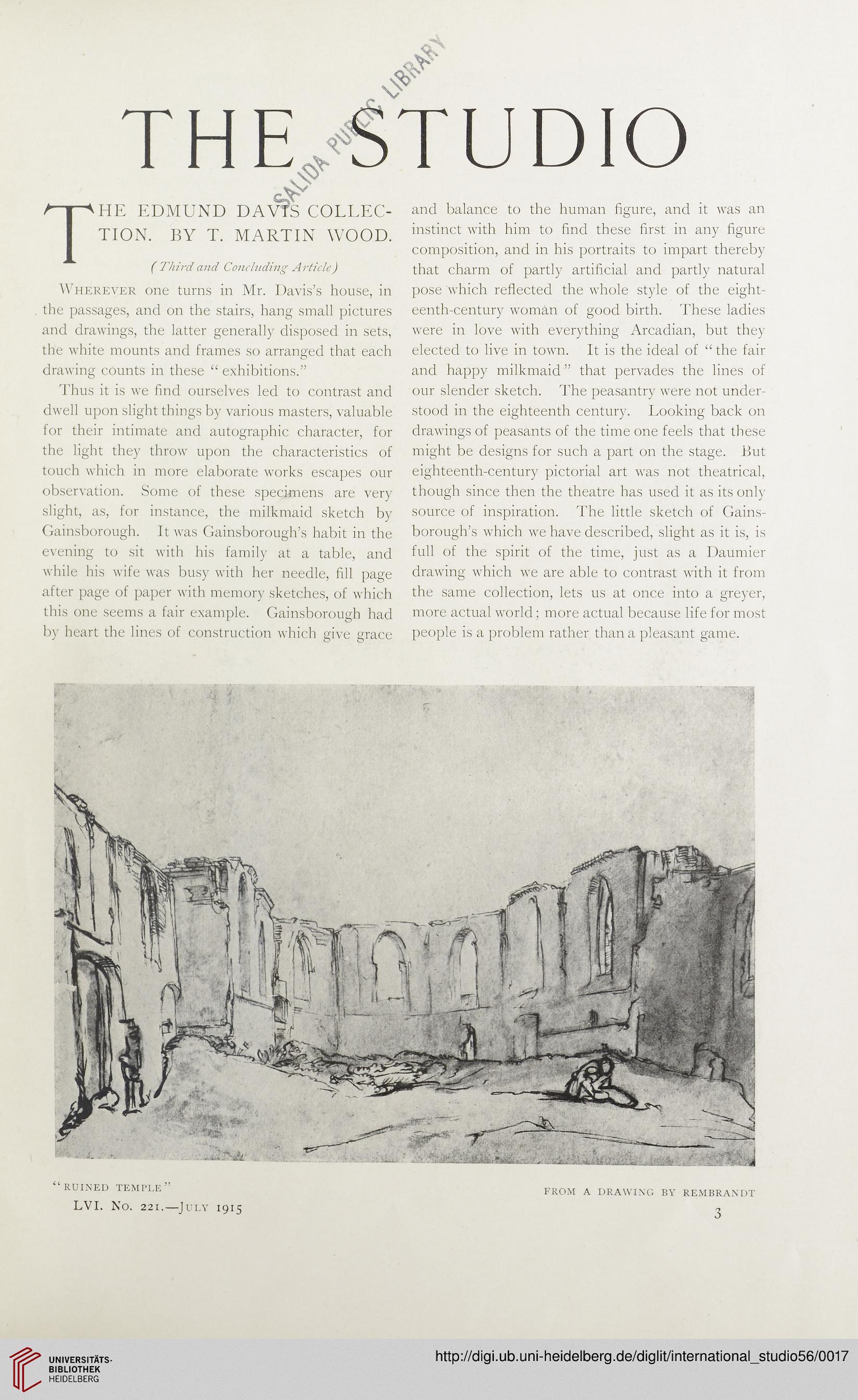( Third and Concluding Article)
Wherever one turns in Mr. Davis’s house, in
the passages, and on the stairs, hang small pictures
and drawings, the latter generally disposed in sets,
the white mounts and frames so arranged that each
drawing counts in these “ exhibitions.”
Thus it is we find ourselves led to contrast and
dwell upon slight things by various masters, valuable
for their intimate and autographic character, for
the light they throw upon the characteristics of
touch which in more elaborate works escapes our
observation. Some of these specimens are very
slight, as, for instance, the milkmaid sketch by
Gainsborough. It was Gainsborough’s habit in the
evening to sit with his family at a table, and
while his wife was busy with her needle, fill page
after page of paper with memory sketches, of which
this one seems a fair example. Gainsborough had
by heart the lines of construction which give grace
and balance to the human figure, and it was an
instinct with him to find these first in any figure
composition, and in his portraits to impart thereby
that charm of partly artificial and partly natural
pose which reflected the whole style of the eight-
eenth-century woman of good birth. These ladies
were in love with everything Arcadian, but they
elected to live in town. It is the ideal of “ the fair
and happy milkmaid” that pervades the lines of
our slender sketch. The peasantry were not under-
stood in the eighteenth century. Looking back on
drawings of peasants of the time one feels that these
might be designs for such a part on the stage. But
eighteenth-century pictorial art was not theatrical,
though since then the theatre has used it as its only
source of inspiration. The little sketch of Gains-
borough’s which we have described, slight as it is, is
full of the spirit of the time, just as a Daumier
drawing which we are able to contrast with it from
the same collection, lets us at once into a greyer,
more actual world; more actual because life for most
people is a problem rather than a pleasant game.
HE EDMUND DAVTS COLLEC¬
TION. BY T. MARTIN WOOD.
“RUINED TEMl’I.E FROM A DRAWING BY REMBRANDT
LVI. No. 221.—July 1915
3
Wherever one turns in Mr. Davis’s house, in
the passages, and on the stairs, hang small pictures
and drawings, the latter generally disposed in sets,
the white mounts and frames so arranged that each
drawing counts in these “ exhibitions.”
Thus it is we find ourselves led to contrast and
dwell upon slight things by various masters, valuable
for their intimate and autographic character, for
the light they throw upon the characteristics of
touch which in more elaborate works escapes our
observation. Some of these specimens are very
slight, as, for instance, the milkmaid sketch by
Gainsborough. It was Gainsborough’s habit in the
evening to sit with his family at a table, and
while his wife was busy with her needle, fill page
after page of paper with memory sketches, of which
this one seems a fair example. Gainsborough had
by heart the lines of construction which give grace
and balance to the human figure, and it was an
instinct with him to find these first in any figure
composition, and in his portraits to impart thereby
that charm of partly artificial and partly natural
pose which reflected the whole style of the eight-
eenth-century woman of good birth. These ladies
were in love with everything Arcadian, but they
elected to live in town. It is the ideal of “ the fair
and happy milkmaid” that pervades the lines of
our slender sketch. The peasantry were not under-
stood in the eighteenth century. Looking back on
drawings of peasants of the time one feels that these
might be designs for such a part on the stage. But
eighteenth-century pictorial art was not theatrical,
though since then the theatre has used it as its only
source of inspiration. The little sketch of Gains-
borough’s which we have described, slight as it is, is
full of the spirit of the time, just as a Daumier
drawing which we are able to contrast with it from
the same collection, lets us at once into a greyer,
more actual world; more actual because life for most
people is a problem rather than a pleasant game.
HE EDMUND DAVTS COLLEC¬
TION. BY T. MARTIN WOOD.
“RUINED TEMl’I.E FROM A DRAWING BY REMBRANDT
LVI. No. 221.—July 1915
3




